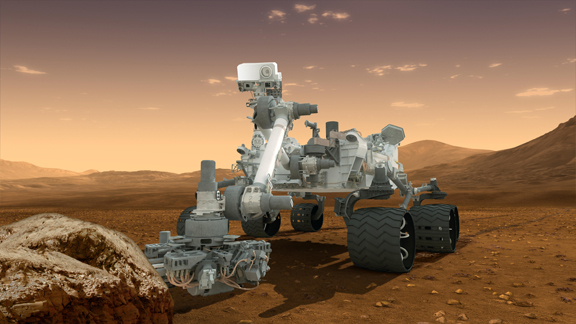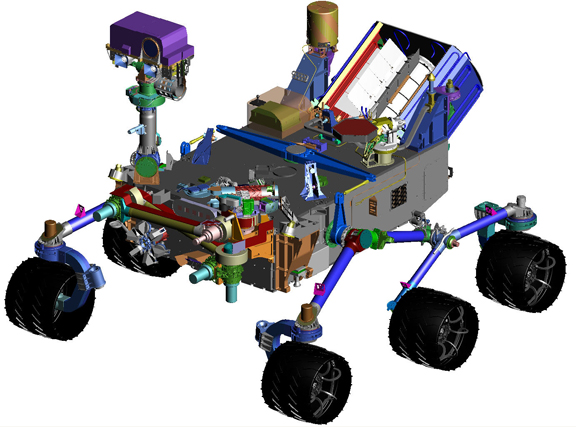Latest News
August 7, 2012
It takes about 14 minutes for a signal from Curiosity rover to reach Earth. From Mars’ atmosphere, it takes the rover about 7 minutes to reach the surface. That means, on March 5, by the time NASA got words that Curiosity had entered the planet’s top atmosphere, the spacecraft had either crashed into or settled on Mars’ soil. Seven more agonizing minutes would pass before the scientists knew if they should uncork the champagne or face a disappointed worldwide audience.
The next 7 minutes (“7 Minutes of Terror,” according to NASA’s promotional video) was an agonizing wait for the rover’s creators. What followed would either confirm or disapprove all the engineering instincts, calculations, and assumptions that went into Curiosity’s design. In its descent, Curiosity would execute a series of critical maneuvers.
While hurtling down at 13,000 MPH, the rover had to open a supersonic parachute to slow itself down and prepare for a touchdown. It had to detach its bottom cover so the internal radar could, in a manner of speaking, “see” the landing zone. For the second phase of its descent, it had to remove the parachute, then activate its rockets. Since completing the entire descent in rockets would create a dust storm that jeopardizes the rover’s delicate mechanism, the rover must complete the last 20 meters of the landing in a crane, dangling from its top cap. Once rover was on the ground, the rocket-propelled top had to detach and fly off to a distance to avoid crashing into the craft below. This whole sequence of finely calibrated events must occur without intervention from the command center. In those 7 minutes, rover was on its own, driven by nothing but 500,000 lines of code.
Tom Rivellini, a NASA Entry, Descent, Landing (EDL) engineer, summed it up: “The computer has to do it, all by itself with no help from the ground. If any one thing goes wrong, or doesn’t go just right, it’s game over.”
Even though Curiosity’s treacherous descent is a one-time event, EDL engineers have already played out this event hundreds of times in pixels, in simulation exercises driven by computer-aided engineering (CAE) software. This gave the project team confidence that the craft was adequately designed to withstand the heat buildup during atmosphere entry. (“The heat shield—It’ll heat up and glow like the surface of the sun,” predicted Adam Steltzner, a NASA EDL engineer.) They had made sure the 100 LB supersonic parachute could put a break on the 65,000 LB force of the falling craft. They had calculated the right altitude at which to activate the radar so it could guide the craft to the landing zone. Curiosity’s autonomous operations that kicked into gear on August 5 had played out countless times inside powerful computers and server clusters, in simulated conditions that closely mimics Mars’ climate.
The anxiety and anticipation of the 7 momentous minutes was also shared by executives at Siemens PLM Software, which supplied some of the mechanical modeling and simulation programs used by NASA. Doug McCuistion, NASA director of the Mars Exploration Program, said, “[Siemens software helps us] not only to manage the drawings and procedures but also to help design the systems. So it was very useful to be able to test the parts and test the interfaces with them before we actually had to assemble the system.”
Siemens’ NX is the Jet Propulsion Laboratory’s (JPL) standard package for computer-aided design, engineering, and manufacturing. JPL also uses Siemens’ Teamcenter software to manage projects and collaboration.
University of Leicester Space Research Center, another Siemens software user, also has a vested interest in the success of Curiosity. The scientists at the Space Research Center have been involved in missions to Mars, Mercury, Saturn, and Jupiter. They’re also involved in works on the successor to Hubble Telescope.
Ivor McDonnell, mechanical engineer at the center, said, “We need to make sure our hardware can withstand the vibration load. Because hardware development is very expensive, we use the NX tools to predict what stresses our hardware is going to be subjected to during these launch-level load.”
Piyal Samara-Ratna, CAD IT manager for the center, explained, “We find that the Nastran solver [part of NX’s simulation function] is a solver commonly used in the industry, so it allows us to work effectively with our partners. We also find that tools are particularly effective in providing good correlation to the actual design environment.”
No matter how many times rover’s landing has been simulated, NASA faced great odds. The job, by NASA’s own admission has “zero margin of errors.” Real-world surprises that were not anticipated—dust storm, electrical failures, atmospheric changes, to name but a few—could have thwarted Curiosity’s mission.
“When people look at it, it looks crazy,” admitted NASA’s Stetlzner. “Sometimes when we look at it, it looks crazy. It is the result of reasoned engineering thought, but it still looks crazy.”
In modern engineering projects, driven primarily by financial and commercial interest, every engineering decision is influenced by the fear of risk. Few, if any, encourage attempting something as crazy as Curiosity’s landing, on a red planet that could, in any given moment, be somewhere between 56 million to 401 million kilometers away from Earth.
Yet, despite our natural inclination to be risk-averse, Curiosity got the better of us.
Here’s to Humanity’s spirit of adventure! Here’s to Curiosity!
NASA JPL’s “7 Minutes of Terror” video below:
Subscribe to our FREE magazine, FREE email newsletters or both!
Latest News
About the Author
Kenneth Wong is Digital Engineering’s resident blogger and senior editor. Email him at [email protected] or share your thoughts on this article at digitaleng.news/facebook.
Follow DE







